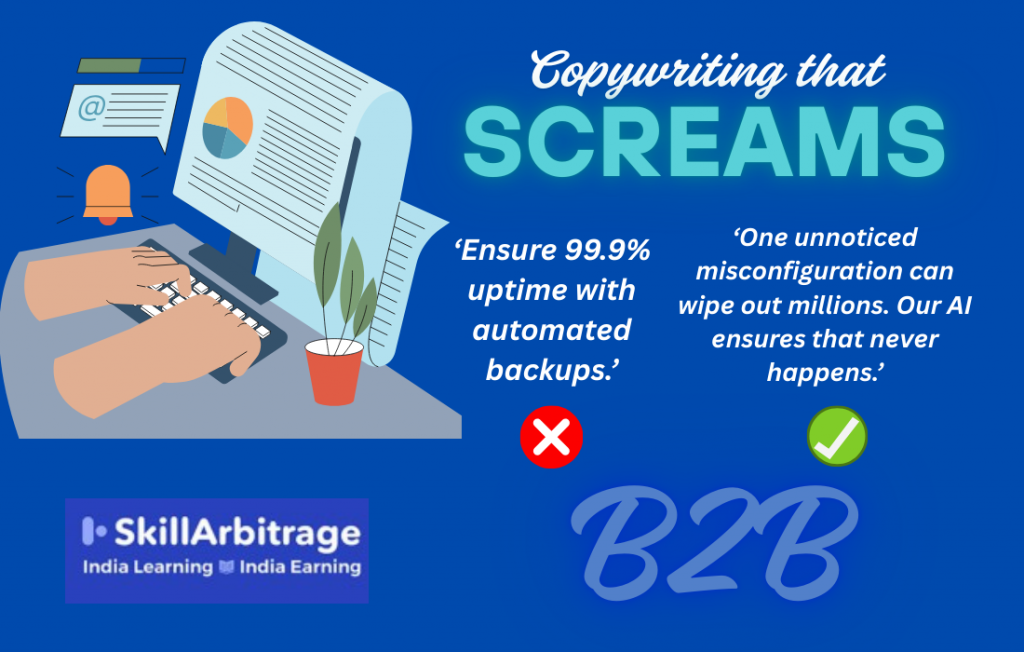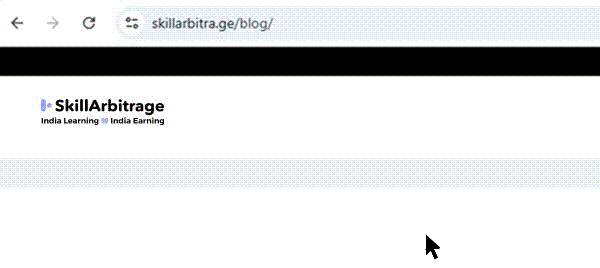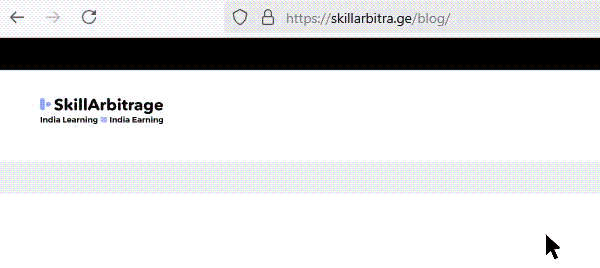This article is for Indian freelance copywriters who want to break into high-paying B2B writing but struggle to make their copy stand out. You’ll learn a risk management insight by Nassim Nicholas Taleb applied to copywriting that truly drives B2B buying decisions and why most freelancers fail to tap into it. By the end, you’ll know how to craft messaging that speaks to what matters most so businesses see your copy as essential, not optional.
Table of Contents
Previously on Magnetic Headlines…
Swathi had one shot to make her perfume brand unforgettable. If her headlines didn’t stop readers in their tracks, her articles and her business would be ignored.
With the pressure on, Raghunandan taught her 38 battle-tested headline techniques from Eugene Schwartz, transforming her writing into a magnet for attention.
But in the world of B2B, attention isn’t enough.
High-value B2B clients don’t just need a clever hook. They need confidence.
Now, it’s Raghunandan’s turn to solve this problem.
As AI and cheap freelancers flood the market, how does a copywriter prove they’re the only choice?
It’s time to master a chaos-proof copy trick that makes B2B clients choose you every time.
(Continued…)
Raghunandan stared at his inbox, waiting. After he got his first taste of business, having started his own funnel, he had become very interested in B2B writing. He had been trying to pitch to B2B clients since then.
He had just sent his first full copy draft to his new B2B SaaS client. A veritable milestone after weeks of outreach, calls, and negotiations. This was supposed to be his breakthrough into high-ticket B2B writing.
He refreshed.
The reply finally came in.
“Looks good. Thanks.”
That was it. No excitement. No “This is amazing!” No “Wow, you nailed it!”. The kind of reactions he always got from his lifestyle brand clients.
Swathi, sitting across from him, noticed his face drop. “What happened?”
Raghunandan exhaled. “They don’t hate it… but they don’t love it either.”
She frowned. “Let me see it.”
Raghunandan pulled up the copy. “I followed everything that works for lifestyle brands. Hooked them with a bold opening, made it conversational, positioned the product benefits…”
Parvathishankar looked up from his book. “And yet, it’s falling flat.”
Raghunandan nodded. “I don’t get it. If this were a skincare brand or a fashion startup, they’d be throwing fire emojis at me.”
Parvathishankar set his book down. “That’s because B2B isn’t selling beauty, fun, or status.”
His words rang. “They’re selling survival.”
Raghunandan frowned. “Survival?”
Parvathishankar smirked. “Welcome to B2B.”
Raghunandan crossed his arms. “But this SaaS isn’t some life-or-death thing. It’s just an invoicing tool.”
Parvathishankar raised an eyebrow. “To you, maybe. But to their clients? The ones using it to manage cash flow, avoid late payments, and keep their businesses running?”
Write for your client’s clients
Parvathishankar leaned back. “Who’s your real audience?”
Raghunandan frowned. “The client, obviously.”
Swathi shook her head. “Wrong. Your client isn’t the one buying their own product.”
Raghunandan hesitated. “So… I should write for their customers instead?”
Parvathishankar grinned. “Exactly. A CFO isn’t buying software just because it sounds good. They buy because their boss demands better cash flow.”
Swathi crossed her arms. “If you write copy that only impresses your client, it dies in the inbox. But if you write for their customers, the people who drive their fears, their KPIs, and their decisions, you create copy that sells.”
Raghunandan nodded slowly. “Okay… So I need to write for the people under the pressure, not just the person reading my proposal.”
Swathi nodded. “If a small business misses a few invoices, what happens?”
“They run out of money.”
“And then?” Parvathishankar pressed.
“They struggle to pay rent, suppliers, employees…oh.” Raghunandan stopped mid-sentence. He saw it now.
Swathi patted him on the back sympathetically. “And that’s what your copy missed.”
Parvathishankar leaned back. “You focused on features and benefits related to efficiency improvement. They’re nice-to-haves. But SaaS buyers don’t wake up sweating over convenience. They wake up sweating over existential risks. The things that could kill their business.”
Raghunandan tapped his fingers on the table. “So, if I want them to care, I need to make their worst fears feel real.”
Parvathishankar nodded. “With AI pumping out decent copy and cheap freelancers undercutting rates, businesses aren’t paying for ‘good writing’ anymore. They’re paying for risk mitigation. And if you don’t make your copy scream ‘Choosing me is the safe bet,’ you’ll be replaced.”
Nassim Nicholas Taleb’s Precautionary Principle
Raghunandan sat back, deep in thought. Everything Parvathishankar and Swathi had just told him made sense. B2B buyers weren’t looking for ‘nice-to-have’ solutions. They were looking for protection from catastrophe.
But then a new question crept in.
“If these companies are so desperate to avoid disaster,” he said, “why don’t they jump at the best solutions the moment they find them?”
Parvathishankar smirked. “Because in B2B, the fear of making a mistake often outweighs the fear of staying the same.”
Swathi turned her laptop toward them. “The Precautionary Principle (PP) explains this. It states:
‘If an action or policy has a suspected risk of causing severe harm to the public domain (affecting general health or the environment globally), the action should not be taken in the absence of scientific near certainty about its safety. Under these conditions, the burden of proof about absence of harm falls on those proposing an action, not those opposing it.’ ― Nassim Nicholas Taleb”
Raghunandan leaned back. “So, a company should be eager to adopt the best solution, right?”
Parvathishankar was animated. “You’d think so. But in reality, the more complicated a solution appears, the more resistant buyers become.”
Swathi scrolled down on her laptop. “Here’s why. The Precautionary Principle is best summarized as: ‘If an action has the potential for severe harm, the burden of proof falls on those proposing it, not those opposing it.’” That’s why a manager is hesitant to adopt anything they don’t fully understand.”
She opened a finance software discussion on Reddit and showed Raghunandan a discussion. “If a manager can’t personally grasp how a system works, they fear unintended consequences. As a result, they default to avoiding change, even if the status quo is riskier.”
Parvathishankar pointed at her screen. “Think about it:”
AI-powered finance tools? ‘What if it makes the wrong decision?’
Blockchain-based security? ‘What if a bug locks us out of our own system?’
Fully automated AP processing? ‘What if it pays the wrong vendor?’
Swathi nodded. “This is why B2B buyers hesitate. They fear hidden dangers more than known inefficiencies.”
Raghunandan exhaled. “So… companies don’t just buy products that solve problems. They avoid products that might create new ones.”
Parvathishankar sat on the windowsill and spoke in Raghunandan’s direction. “Yes, the devil you know is better than the devil you don’t.”
Swathi nodded. “Not all risks are equal. There are two types: regular risks, which are recoverable, and multiplicative risks, which spiral out of control. Taleb explains:
‘Never compare a multiplicative, systemic, and fat-tailed risk to a non-multiplicative, idiosyncratic, and thin-tailed one.’
― Nassim Nicholas Taleb, Skin in the Game: Hidden Asymmetries in Daily Life
Raghunandan raised an eyebrow. “Meaning?”
Parvathishankar tapped the table. “A minor setback in a marketing campaign? That’s thin-tailed, aka manageable. But an accounting error that triggers an IRS investigation? That’s fat-tailed, aka it can spiral out of control and destroy a company.”
Parvathishankar explained. “This is why real risk management isn’t about complexity. It’s about simplicity. A hospital doesn’t focus on ‘workflow efficiency’ before ensuring they don’t kill patients. A bank doesn’t chase ‘higher returns’ if there’s a nonzero chance of collapse. Existential threats come first. Always.”
Raghunandan exhaled. “Ok, so there are two main types of risks. Regular risk and multiplicative risk.”
Parvathishankar nodded. “Exactly. And in your copy, you must show that ignoring your product exposes them to a multiplicative catastrophe, however improbable.
Turning Taleb’s Precautionary Principle into B2B copy that sells
Raghunandan rubbed his chin. “Okay, I get the logic. Businesses eliminate existential threats before optimizing anything else. But how does that change the way I write copy?”
Parvathishankar leaned forward. “Simple. The Precautionary Principle (PP) means your copy has to do two things:
1. Make the buyer feel that not choosing your product is the riskiest decision they could make.
2. Make them confident that your solution eliminates risk without creating new dangers.
Swathi nodded. “You’re not just selling efficiency. You’re selling protection from disaster. Think about it. If your audience believes that ignoring your solution could lead to an irreversible problem, they’ll buy without hesitation.”
Raghunandan exhaled. “Alright… but how do I actually apply that?”
1. Find the multiplicative catastrophes
Parvathishankar pulled up a business news site on his phone. “Every industry has these ‘runaway risks’ or problems that don’t just cause small losses but trigger chain reactions.”
Swathi gestured at the screen. “Case in point. This article on how a single unpaid invoice caused an entire supply chain to collapse.”
Raghunandan leaned in. “Wait, what happened?”
Swathi scrolled. “A mid-sized supplier delayed payments to vendors because their client didn’t pay them on time. Those vendors, in turn, couldn’t fulfill orders for another company, which led to product shortages. That shortage affected yet another company that relied on those products… and within weeks, the entire supply chain was wrecked.”
Parvathishankar declared. “That’s what Taleb calls a fat-tailed risk – a small issue that multiplies into a disaster. This is what your copy should highlight.”
2. Case studies sell fear better than hypotheticals
Swathi tapped her screen. “The best way to convince someone that a risk is real? Show them it’s already happened to someone else.”
Parvathishankar nodded. “Businesses ignore theoretical risks, but they pay attention when you show them a real company that suffered a runaway catastrophe.”
Raghunandan scribbled notes. “So, I should dig through business case studies, news reports, and industry research for these ‘chain reaction’ failures?”
Swathi grinned. “Exactly. Then, position your product as the safety net that stops that first domino from falling.”
3. Position your solution as the simplest, risk-free fix
Parvathishankar put his phone down. “Here’s the final piece. Taleb warns that complexity multiplies risk. The more moving parts a system has, the more ways it can fail.”
Swathi pointed at Raghunandan’s notes. “That means your copy has to emphasize how your solution is the simplest way to eliminate catastrophic risk.”
Parvathishankar counted on his fingers. “Your copy should scream instant protection from disaster.”
Then he added, “And people don’t just trust words. They trust proof. Fear makes them listen, but proof makes them act.”
- Proof of Safety: Show them your solution actually works. Case studies, testimonials, or real-world success stories eliminate uncertainty.
- Proof of Low-Friction Adoption: Make them see how switching is seamless. Demo videos, plug-and-play integration, and risk-free trials remove hesitation.
Swathi nodded. “Without proof, they’ll always wonder, ‘But will this really work for me?’”
Parvathishankar nodded. “Remove that question, and you remove the last roadblock to a sale.”
4. Make them feel the fear of ignoring you
Raghunandan’s pen hovered over the page. “So… I have to make them feel the weight of the risk?”
Parvathishankar said excitedly. “Exactly. But not in a vague ‘this is important’ way. Make them visualize the exact disaster they’re inviting.”
Swathi leaned in. “For example, instead of saying,
‘Failing to track overpayments can cost you money,’
say,
‘A single unnoticed overpayment can trigger a cash crunch that delays payroll, leaving your employees unpaid and your best talent walking out the door.’”
Raghunandan exhaled. “That hits way harder.”
Principles of survival-driven copywriting
Raghunandan stared at his notes.
His original copy was smooth and elegant.
But now, it felt useless.
Swathi pointed at his laptop screen. “Look at this line.”
He followed her finger.
“Optimize your invoicing with AI-powered automation.”
A week ago, he would have defended it. Now? He hated it.
Parvathishankar encouraged. “Go ahead. Fix it.”
Raghunandan took a deep breath. He thought back to what they had just discussed. The real fear that kept hospital CFOs awake at night.
He started typing.
“One invoicing mistake can bleed a hospital dry. We make sure that never happens.”
He sat back.
Swathi read it aloud. “That hits harder.”
Parvathishankar nodded. “Now you’re speaking their language.”
Raghunandan exhaled. He suddenly saw everything differently.
This wasn’t about selling software. It was about stopping disasters before they happened.
Parvathishankar leaned forward. “One more time. What’s the job of your copy”?
Raghunandan didn’t hesitate. “Not to sell software but to prevent existential collapse.”
Parvathishankar tapped the table. “Alright. Let’s make this process repeatable. Here’s how you do it every time.”
He grabbed a notepad and wrote:
The 3-step survival-driven copy framework
Step 1: Identify the tail risk
What’s the worst-case scenario if this product didn’t exist?
Instead of “Automate invoicing with ease.”
Write “A single billing error could cost you millions. Stop revenue leaks before they happen.”
Step 2: Frame the product as the only lifeline
How does this product eliminate that existential risk?
Instead of “Get paid faster with automated invoicing.”
Write “Delayed payments kill businesses. We make sure you get paid on time, every time.”
Step 3: Use high-stakes, survival-driven language
Does this copy make the risk feel immediate and unavoidable?
Instead of “Improve cash flow management.”
Write “Cash flow gaps shut companies down. Don’t let yours be next.”
Parvathishankar put the pen down. “Use this.”
Raghunandan read through the framework. He could already see the shift happening in his mind.
He cracked his knuckles. “Alright. Time to rewrite some proposals.”
Swathi did a hair flick. “This time, they won’t just say, ‘Looks good.’”
Parvathishankar raised his tea. “They’ll say, ‘Where do I sign?’”
Using AI for survival-driven B2B copywriting
Raghunandan thought for a whole minute and said, “But this will reduce my speed.”
“If I have to do deep industry-specific research to find multiplicative risk scenarios, it’ll take me weeks!”
Swathi pulled out her laptop. “That’s where AI comes in.”
Raghunandan frowned. “AI can predict risks?”
Parvathishankar chuckled. “No. But it can surface blind spot patterns that businesses ignore until it’s too late.”
Swathi typed a prompt into ChatGPT and turned the screen toward him.
AI prompt
“List the top 5 tail risks for [industry] businesses that could cause severe financial losses, legal trouble, or business failure. Explain why they happen and provide real-world examples.”
The AI started spitting out results.
- For an invoicing SaaS: Missed payments leading to cash flow collapse
- For a cybersecurity tool: A single data breach leading to bankruptcy
- For an HR software: Compliance failure triggering multi-million dollar lawsuits
Raghunandan’s eyes widened. “These aren’t just problems. They’re nightmares.”
When risk becomes reality: The $150M AWS mistake
Parvathishankar tapped his phone and pulled up a news article.
2017: A single Amazon Web Services (AWS) outage cost S&P 500 companies an estimated $150M+ in lost revenue.
One unnoticed typo in a server command triggered a chain reaction of failures. Websites crashed. Transactions halted. Some businesses took days to recover.
Parvathishankar looked up. “Imagine you’re selling cloud infrastructure. What hits harder?”
- ‘Ensure 99.9% uptime with automated backups.’
- ‘One unnoticed misconfiguration can wipe out millions. Our AI ensures that never happens.’
Swathi grinned. “Which one do they click?”
Raghunandan exhaled. “The second one.”
Parvathishankar nodded. “That’s the power of tail risks.”
Raghunandan looked at his notes. His old copy was all about convenience, but his new version? It wasn’t selling ease. It was selling survival.
B2B buyers fear the risk of ruin more than they love efficiency
“And that’s a good thing.” Swathi scrolled through a report.
According to IBM, the average cost of a data breach in 2023 was $4.45M and 60% of small businesses shut down within six months of a cyberattack.
She raised an eyebrow. “Now, which copy lands harder?”
- ‘Enhance your cybersecurity with AI monitoring.’
- ‘60% of small businesses don’t survive a cyberattack. Don’t be one of them.’
Raghunandan nodded slowly. “Damn.”
Isn’t this too negative?
He frowned. “But won’t some clients say this sounds too alarmist?”
Parvathishankar leaned in. “Let me ask you this. Does a cybersecurity company say, ‘Reduce breaches by 15%’ or ‘One attack can bankrupt you’?”
Swathi pointed at him. “And which one makes buyers act immediately?”
Raghunandan cracked his knuckles. “Got it. Fear isn’t manipulation. It’s clarity on consequences.”
Swathi tapped the table. “That’s it. No more ‘nice-to-have’ copy. Lead with survival-driven messaging.”
Parvathishannkar took a bow. “And that’s how you turn any B2B product into a must-have.”
(To be continued…)







 Allow notifications
Allow notifications
